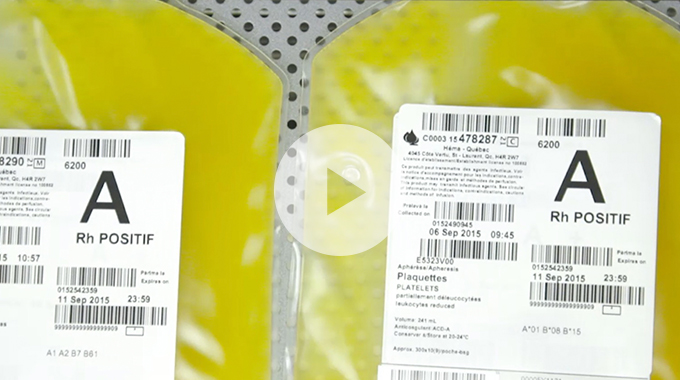Processing the donation
Blood donation: what happens after?
 |
A whole blood donation generates several labile blood products.
Our laboratory staff members treat the whole blood collected to extract its various components.
When the blood bags arrive at Héma-Québec, a veritable race against the clock begins. Everything possible is done, according to very strict regulatory controls, to preserve this precious fluid. The reason is simple: blood is a perishable good, and its shelf life is limited.
Centrifugation and leukoreduction
The procedure used to produce blood components from whole blood is centrifugation, which consists in separating the constituents of different masses with the help of centrifugal force.
A first centrifugation of the whole blood donation aims at separating the red blood cells from the plasma. During the centrifugation process, the red blood cells are deposited at the bottom of the collection bag. The plasma remains on the surface, and the white blood cells and platelets remain suspended in the plasma above the red blood cells.
The plasma, rich in platelets, is then extracted into one of the satellite bags.
Almost all of the white blood cells are removed through filtration to reduce the risk of a transfusion reaction. This step is called leukoreduction.
All that remains in the original collection bag are the red blood cells to which a nutrient-rich solution will be added. These are the packed red blood cells.
The bag of platelet-rich plasma is then centrifuged to extract the platelets.
Following the whole blood processing sequence, we are left with three blood components: plasma, platelets and red blood cells (packed red blood cells). There is a fourth component: cryoprecipitate, which is obtained by freezing and thawing plasma.
These four perishable components constitute what we call labile blood products.
A patient’s need for blood components will vary depending on their state of health. Some patients require plasma, others need platelets, while even others need packed red blood cells. The transformation of whole blood into various products promotes more effective treatment because patients can receive only the blood components they require.
All of the labile blood products we manufacture are stored in a quarantined area until all of the donation qualification analyses (blood typing and screening tests) have been completed. Afterwards, the products that meet the standards will be properly stored before finally being sent out to the hospitals.
